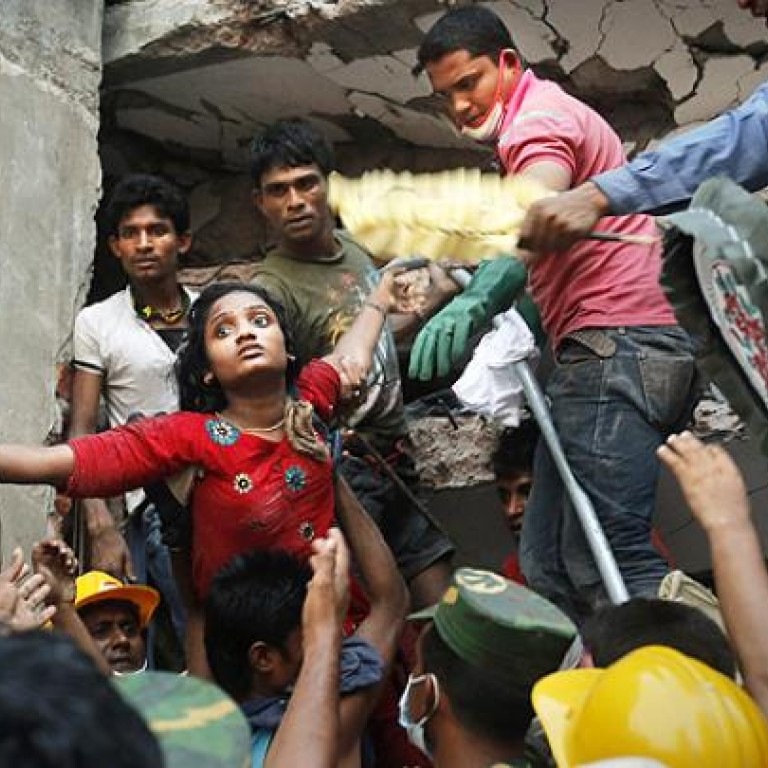
Dozens pulled alive from Dhaka factory as toll hits 256
Screams filtering through the cracks in the concrete suggest more survivors awaiting help
Dozens of workers were found alive on Thursday as they huddled in the wreckage of a collapsed garment factory bloc in Bangladesh, a rare success for rescuers who have pulled out 251 bodies.
In an announcement greeted by wild applause from thousands of relatives at the scene, an army spokesman initially announced that 40 survivors had been discovered together in a room, but the figure was later revised to 24.
Screams filtering through the cracks in the concrete suggested more survivors were awaiting help, but a steady stream of bodies saw the recorded death toll almost double on Thursday and hundreds remain unaccounted for.
Working with floodlights and hand torches, rescuers crawled through the cracks and pulled out three woman garment workers alive from the rubble at 11.30pm Bangladesh time, fire service director Mahbubur Rahman said.
"We’ve also located several pockets inside the wreckage where many people are still trapped. We could hear their screams. They were given food, water and oxygen."
The collapse of the building on Wednesday on the outskirts of the capital is the worst industrial accident in the country’s history and is the latest in a spate of tragedies in the “Made in Bangladesh” clothing sector.
It prompted new criticism of Western brands who were accused by activists of placing profit before safety by sourcing their products from the country despite its shocking track record of deadly disasters.

“The death toll is now 250,” Moshiuddowla Reza, a senior police officer of Dhaka district, told reporters from the disaster site, adding more bodies were being recovered and that most of those who died are female garment workers.
Safety problems and poor working conditions plague the textile industry in Bangladesh, the world’s second-biggest clothing exporter after China.
Last November a blaze at a factory making products for Walmart and other Western labels left 111 people dead, with survivors describing how fire exits were kept locked by site managers.
Only British low-cost fashion line Primark and Spanish giant Mango have acknowledged having their products made in the collapsed factory bloc, while a host of brands including Wal-Mart and France’s Carrefour are investigating.
Those who’re involved, especially the owner who forced the workers to work there, will be punished. Wherever he is, he will be found and brought to justice
Italian fashion line Benetton denied having a supplier in the building but a local workers’ group provided documents showing apparent orders from the company in August and September last year.
Survivors said the building developed visible cracks on Tuesday evening, but factory bosses had demanded staff return to the production lines despite a police evacuation order.
One manager for the New Wave Styles company, one of the five manufacturers in the building, told how the owner had consulted an engineer but then ignored his warnings.
“Those who’re involved, especially the owner who forced the workers to work there, will be punished,” Prime Minister Sheikh Hasina told lawmakers. “Wherever he is, he will be found and brought to justice.”
At the scene of the disaster, relatives desperate for news descended in their thousands, clutching photographs and hoping to see their missing loved ones pulled out by firemen and soldiers.

But others were less lucky, with body after body laid out on the grounds of a nearby school for identification.
“I’ve seen all the bodies. My sister was not among them. She is also not in any of the hospitals,” said Mukta Begum, holding the photo of her younger sibling Suryaban, a garment worker.
Babul Akhter, head of the Bangladesh Garments and Industrial Workers Federation, said that the factory owners – who have gone into hiding – would likely escape justice despite the outcry.
“Garment entrepreneurs are above the law here. There is hardly any example of an owner being prosecuted for this kind of outright murder,” he said.
“The Western retailers are also complicit because they give a blind eye to the manufacturers’ shoddy practices.”
Before the 24 were found, Ahmed Ali, the national fire service chief, told reporters that 20 people had been rescued.
“We could still hear desperate cries for help from several places underneath the concrete heaps. Volunteers sent food and water to them through holes,” he said, adding that rescuers would work through the night under floodlights.

Mango, Benetton, C&A, Wal-mart among customers of firms in Dhaka collapse
Ether Tex was located on the 5th floor of the Rana Plaza building that collapsed. Its website, now offline, said its 530 workers made up to 960,000 pieces of clothing a year. It claimed to have a passing grade for safety and other business standards from SOCAM, a group that audits garment factories on behalf of European fashion company C&A. The firm said its customers included Wal-Mart.
New Wave is a group of three companies that says it makes shirts, trousers and other garments for US, Canadian and European retailers. Two of the firms in the group - New Wave Bottoms and New Wave Style - were located, respectively, on the second, and the 6th and 7th floors of the collapsed building. The New Wave website lists 27 retailers as its main customers, including Mango of Spain, Dress Barn of the United States, The Children's Place of Canada and the Asian arm of Benetton, based in Hong Kong.
Phantom Apparels operated a garment factory called Phantom-TAC in conjunction with Spain's Textile Audit Company on the 4th floor of the collapsed building. The Phantom-TAC website says it is "committed to reaching a high standard of working conditions". It claimed to have a comprehensive auditing system that allowed it to "monitor and analyse daily the conditions in our factory", The 20,000 sq ft factory could make up to three million garments a year. It does not list its customers.
